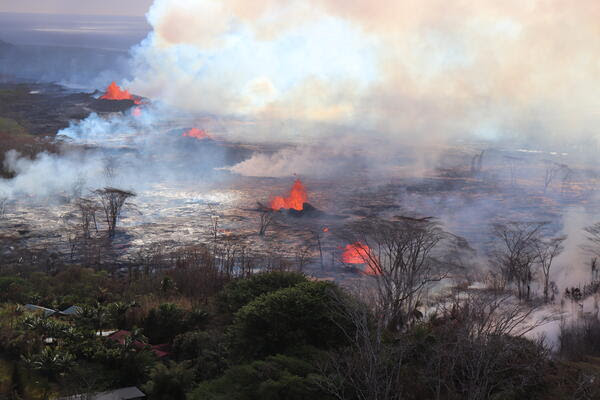Volcano Watch: Assembly of volcano scientists to gather in Hilo
“Volcano Watch” is a weekly article and activity update written by U.S. Geological Survey Hawaiian Volcano Observatory scientists and affiliates. Today’s article is by Hawaiian Volcano Observatory geologist Kendra J. Lynn.
What is the collective noun for a group of volcano scientists?
While some tongue-in-cheek responses might be “an eruption of volcanologists” or “a swarm of seismologists,” we’ll stick to “an assembly of volcano scientists.”
Volcano scientists from around the world will gather from Feb. 9-14 in Hilo for the American Geophysical Union Chapman Conference on Caldera-forming Eruptions at Basaltic Volcanoes: Insights and Puzzles from Kīlauea 2018 and Beyond.
The meeting is directly aligned with the U.S. Geological Survey’s Volcano Hazards Program mission — “to enhance public safety and minimize social and economic disruption from volcanic unrest and eruption.”

Basaltic caldera-forming rift eruptions, such as the 2018 lower East Rift Zone eruption and summit collapse of Kīlauea, represent an underappreciated hazard for many global communities, but also a chance to better understand some of Earth’s most active volcanoes.
A handful of these eruptions have been documented globally in the last half-century, including at Miyakejima (Japan), Piton de la Fournaise (La Réunion) and Bárðarbunga (Iceland).
Kīlauea’s 2018 eruption was its most impactful in centuries, documented in remarkable detail, and involved more than 1 cubic kilometer of basaltic lava flows, a magnitude-6.9 flank earthquake and a major summit collapse.
Observations from Kīlauea and similar eruptions around the globe offer an unprecedented opportunity to understand calderas and associated rift systems as well as the dynamics of their interplay, but a community-driven synthesis has been lacking.
Numerous fundamental scientific questions also remain.
The experts gathering on Hawaiʻi Island will assess current understanding, share insights and map out work on critical outstanding issues. Resulting insights should prove valuable when the next large basaltic caldera collapse takes place somewhere on Earth.
This conference will bring together an interdisciplinary assembly of volcano scientists to contrast observations from historic global caldera-rift eruptions, establish state-of-the-art understanding, identify important questions and initiate lasting new research efforts.
We will address the causes of these eruptions, dynamics of basaltic caldera collapses, interaction between summit calderas and rift zones, geometry and physical properties of magma storage and challenges in forecasting associated hazards.
A significant investment in research and monitoring of Hawai‘i’s volcanoes was made through the Additional Supplemental Appropriations for Disaster Relief Act of 2019 , which provided supplemental funding to for recovery and rebuilding activities in the wake of the 2018 Kīlauea eruption.
Results from recent large-scale science experiments at Kīlauea supported by this funding will be shared and discussed during the coference. Field trips will give participants an opportunity to visit important sites on the volcano.
Finally, teams will be formed to discuss science questions in detail and establish priorities for additional work following the meeting.

The conference, organized by U.S. Geological Survey and academic volcano researchers, is bringing more than 150 scientists representing 15 countries and the United States together for presentations about volcanoes around the globe, discussions, workshops and field trips.
Roughly 25% of presenters are undergraduate or graduate students — a new generation of volcano scientists tackling our field’s biggest challenges. We are very excited that several University of Hawai‘i students from the Hilo and Mānoa campuses are among those presenting their research at the meeting.
Additionally, partners from Hawai‘i County Civil Defense, Hawai‘i Volcanoes National Park, Hawaiian Volcano Education & Resilience Institute, Pacific Tsunami Museum and Pacific Tsunami Warning Center will participate.
Winning art and haiku submissions from the Hawaiian Volcano Observatory 2025 Volcano Awareness Month Art & Poetery Contest will also be on display during the weeklong conference.
We look forward to a productive week learning with our colleagues and partners.
E komo mai to the assembly of volcanologists that is soon to arrive!
Volcano Activity Updates
Kīlauea is erupting. Its U.S. Geological Survey Volcano Alert level is at Watch.
The summit eruption at Kīlauea volcano that began Dec. 23, 2024, in Halemaʻumaʻu Crater continued during the past week with one eruptive episode.

Episode 8 was active from the evening of Feb. 3 until the evening of Feb. 4. Kīlauea summit has been inflating since the most recent eruptive episode ended. Resumption of fountaining is possible from Feb. 8-11 if summit inflation continues at its current rate.
Sulfur dioxide emission rates are elevated in the summit region during active eruption episodes.
No unusual activity has been noted along Kīlauea’s East Rift Zone or Southwest Rift Zone.
Mauna Loa is not erupting. Its Volcano Alert Level is at Normal.
No earthquakes were reported felt in the Hawaiian Islands during the past week.
Hawaiian Volcano Observatory continues to closely monitor Kīlauea and Mauna Loa.
Visit the observatory website for past “Volcano Watch” articles, Kīlauea and Mauna Loa updates, volcano photos, maps, recent earthquake information and more. Email questions to askHVO@usgs.gov.
Sponsored Content
Comments








